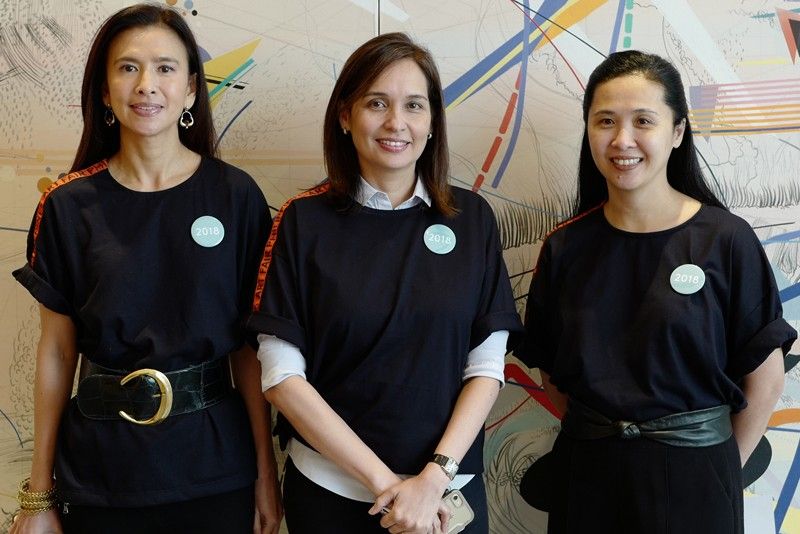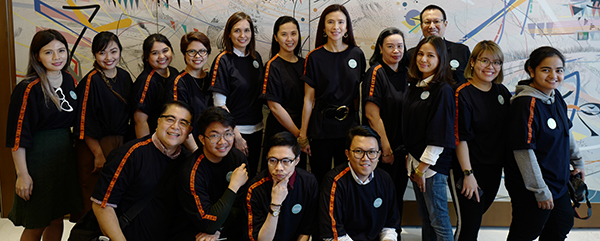Trickie Lopa, Lisa Periquet & Dindin Araneta: Are we curators? Or are we enablers of an art fair experience?

The beauty and brains behind Art Fair Philippines: Trickie Lopa, Lisa Periquet and Dindin Araneta
‘A few years ago, at the ArtHK when they decided to work with a curator to choose their special exhibits, the director described it as ‘giving up the fun part.’ Maybe that’s why we still do it for Art Fair Philippines: we’re loath to give that up!’
This is all about the process of setting up the fair, an opaque and exotic process to most. Here, Trickie Lopa, Lisa Periquet, and Dindin Araneta, organizers of Art Fair Philippines (AFP), speak about their approach to the annual event drawing over 10,000 visitors per day in 2017, roughly two percent of the population of Makati. While there are some very serious gaps in this inquiry, further discussion is hoped to continue elsewhere with, hopefully, more artists as part of the conversation.
PHILIPPINE STAR: There seems to be a clear expression of AFP’s desire to foreground Philippine photography this year. Past iterations of the fair may have not exactly done this, ie. begin with a theme (although one might argue that the scale of and the amount of space given to certain works in the past may have given the impression that certain artists or works are emphasized). It is also a certain kind of photography — broadly documentary, with the Masferre exhibition recalling ethnographic image-making. Could you please share how these decisions came about? And why now? Curiously, some commentators have discouraged art fair visitors to take selfies in front of the art.
Dindin Araneta: In 2016, we invited At Maculangan for a solo exhibition on photography at the art fair. Titled “Corners Amplify Low Frequency,” the suite of portrait photographs were shot inside a foley studio on a project for Paul Pfeiffer in Bangkok. It was the first time At witnessed the work of two foley artists and became interested in them and their workspace. He took their photographs as they threaded the sounds of a boxing match. Thus, support for photography by Art Fair Philippines began two years ago. The Julius Baer curator, Barbara Staubli, took notice of the exhibition during her visit, and encouraged us to show more lens-based works at the future fairs. The following year, Barbara and Shanghai-based gallerist Xan Ru of XuArtspace (who had photographs by Man Ray in her art fair booth) had a talk on photography as part of the Art Fair Ph/Talks 2017 series.
Lisa Periquet: I would describe our curatorial approach to the fair as a subtle one. There are many curatorial decisions we’ve made over the years that may not be outright declarations of a specific curatorial view, but rather, elements of our approach to crafting the fair. Specifically, I would mention our choice of venue and our selection each year of a range of artists to present their work as part of our ArtFairPH/Projects (formerly called Special Exhibitions). When we invited participants for this section, we did not specify what aspect of photography to concentrate on. That many of the exhibitions in this section have turned out to be focused on the documentary aspect of photography is coincidence or perhaps, a sign of the times?

Art Fair Philippines co-founders Dindin Araneta, Lisa Periquet and Trickie Lopa with the rest of the Art Fair Philippines 2018 team Marika Manglapus, Jean Abordo, Irene Venturina, Paulo Bautista, Carizza Chua, Eton De Guzman, Jojo Gloria, Manuel Bautista, Gigi Bautista, Meg De Guzman, Issa Tipace, Aldrin Raymundo and Drea Estrellado.
Would you be keen to answer any criticisms of the fair? Among others I would imagine, for example, how the higher entrance fee and timed entry may not be so warmly welcomed by those who have been accustomed to the AFP’s operations in the past.
Trickie Lopa: We realize that given the number of people who come to the fair, it will not be possible to please everyone. I don’t feel ticklish at all about responding to criticism. I have always been clear to myself about why I continue organizing the fair, but I do realize that people have varied opinions about our efforts. With regard to the higher entrance fee: as the fair gets bigger and we try to improve it, our costs increase commensurately. We take about 10 months to plan the fair, and crafting the venue and enhancing the experience of both participants and visitors have always been a huge part of our planning process. We’ve taken over all the floors of the carpark this year; every time we commandeer another floor, that means that level has to morph into a space that will hold art and people, and the costs to that are tremendous.
Lisa: Annually, we build, in the space of six to eight weeks, what is essentially a temporary, air-conditioned gallery space with exhibit panels limited by the nine-foot-high ceiling and bare cement floors that reveal the art fair’s inner carpark-self. Crafting the physical space of the fair is a constant challenge, taking into account the limitations of a venue that was designed primarily for vehicle parking rather than a five-day art event which saw more than 30,000 visitors in its 2017 edition. Together with our consultant architects, the floorplan is continually tweaked and has developed from an early, relatively uniform grid plan to a more compelling layout of variously-sized dynamic spaces in response to gallery requests as well as the fair’s growing popularity and wider reach which saw an increase in millennials and overseas visitors in its audience base. With each passing year, more space within the car park building (including the roof deck) has slowly been taken over for exhibition areas, food and beverage outlets, retail space, a dedicated lecture tent, sponsors’ exhibit areas and so on. When we began in 2013, the fair was established on a single floor under 3,000 sqm. The sixth year of the Art Fair, 2018, will see the remaining available space within the car park building maximized for its use, with a floor area totaling 13,000sqm over several floors.
Elsewhere art fairs are explicitly curated (“someone is guilty,” according to one curator). How would you describe your role in curating the fair? And what are the particularities in putting together this year’s projects, talks, and public artworks? As in the earlier question, why these works, and why now?
Trickie: A few years ago, I covered ArtHK (as it was then known) for a major daily. I went to the press briefing, and that edition marked the first time that they decided to work with a curator to choose their special exhibits. The director described it as “giving up the fun part.” Maybe that’s why we still do it for AFP: we’re loath to give that up! Kidding aside, we are very hands on with how we organize the fair. I myself put all my heart and soul in it; I believe I speak for the three of us when I say we’re very passionate about art and the artists we keep abreast of. Every aspect of the fair is discussed and debated on, looked over at every angle numerous times. Some things we reach a consensus pretty quickly, others merit additional consideration. For myself, every year, I always put out what I feel very strongly about — whether it’s to highlight an artist for ArtFairPH/ Projects or a take on a subject that I feel would be interesting for the Talks — and see if Lisa and Dindin will feel the same way. I think we’ve always managed to put together a show that reflects a little bit of each of us. I do enjoy it when the fair brings in something new for me as well — when my interest is sparked by working with an artist whose practice I hadn’t been so familiar with or listening to a lecture on something I didn’t have more than a passing awareness for.
Dindin: In an online Artnews feature on “Why So Many Curators Are Working With Art Fairs,” Frieze Focus 2017 advisor Ruba Katrib, who is currently MOMA PS1 curator was interviewed and asked: “While curators might influence markets as a result of their work, they are not meant to be directly concerned with the commercial side of art. Meanwhile, fairs are all about selling. Why do you think this relationship is growing and how do you feel being part of it?” She replied, “As an advisor, we have no role in the sales aspect. Our position is really to bring in our perspectives and contribute to the research the fair is already embarking upon. I think it is important for fairs to include voices that aren’t solely coming from the commercial realm. Some do this better than others, and I do appreciate that Frieze refers to us as advisors as opposed to curators of the section, which is a more appropriate description of what we do.” So I ask myself, are we curators? Or are we enablers of an art fair experience? We put together the projects, the talks, and public artworks through both formal and informal discussions, consultations or conversations with various individuals, including curators, who are integral to the ecosystem of the visual arts. Our functions and responsibilities in organizing the art fair necessitates that we have a clear understanding or appreciation of both the critical realm and commercial realm. Our work involves the management and coordination of all logistical matters involved in setting up the whole art fair. The projects, talks and public artworks are part of the whole. It may be somewhat problematic to refer to us as curators as it’s not an appropriate description of what we do.
Tthe process of administration remains one that will hopefully, continuously be up for discussion and debate not just with the fair’s organizers but with the other multi-headed beings that participate in the knotty, circuitous networks of contemporary art.
* * *
A total of 51 galleries, 36 of which are local, will be participating in Art Fair Philippines 2018. These include 1335Mabini, Altro Mondo Arte Contemporanea, Archivo 1984, ARNDT, Art Cube Gallery, Art Lab: Atelier Cesare & Jean Marie Syjuco, Art Underground, Art Verité Gallery, Artemis Art, Artery Art Space, Artinformal, Asian Cultural Council / Leon Gallery, Avellana Art Gallery, blanc, Boston Art Gallery, Canvas, Cayón, Deck, Edouard Malingue Gallery, Everyday Impunity, Finale Art File, FOST Gallery, Gajah Gallery (Singapore/Yogyakarta), Galerie Anna, Galerie Stephanie, Galleria Duemila, Gallery Kogure Tokyo / NYC, Gallery Orange, J Studio, Kaida Contemporary, Mind Set Art Center, MO_Space, Nunu Fine Art, Paseo Art Gallery, Pinto Art Museum, Salcedo Private View, Secret Fresh, Silverlens, Soka Art, STPI, Taksu, The Crucible, The Drawing Room, Tin-aw Art, Underground, Vinyl on Vinyl, VIVA EXCON, West Gallery, Yavuz Gallery, YOD + Kogure, and Ysobel Art Gallery.
For information, visit www.artfairphilippines.com or follow Art Fair Philippines on Instagram (@artfairph) and Facebook (www.facebook.com/artfairph).
Art Fair Philippines 2018 is co-presented by Ayala Land, Bank of the Philippine Islands, Globe Platinum, and Julius Baer. The Philippine STAR is the newspaper partner of Art Fair Philippines.



















